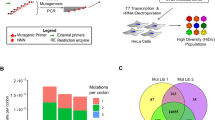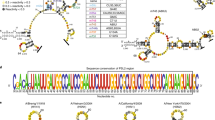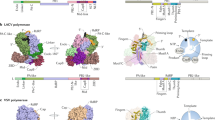Abstract
RNA viruses pose serious threats to human health. Their success relies on their capacity to generate genetic variability and, consequently, on their adaptive potential. We describe a strategy to attenuate RNA viruses by altering their evolutionary potential. We rationally altered the genomes of Coxsackie B3 and influenza A viruses to redirect their evolutionary trajectories towards detrimental regions in sequence space. Specifically, viral genomes were engineered to harbour more serine and leucine codons with nonsense mutation targets: codons that could generate Stop mutations after a single nucleotide substitution. Indeed, these viruses generated more Stop mutations both in vitro and in vivo, accompanied by significant losses in viral fitness. In vivo, the viruses were attenuated, generated high levels of neutralizing antibodies and protected against lethal challenge. Our study demonstrates that cornering viruses in ‘risky’ areas of sequence space may be implemented as a broad-spectrum vaccine strategy against RNA viruses.
This is a preview of subscription content, access via your institution
Access options
Access Nature and 54 other Nature Portfolio journals
Get Nature+, our best-value online-access subscription
$32.99 / 30 days
cancel any time
Subscribe to this journal
Receive 12 digital issues and online access to articles
$119.00 per year
only $9.92 per issue
Buy this article
- Purchase on SpringerLink
- Instant access to full article PDF
Prices may be subject to local taxes which are calculated during checkout






Similar content being viewed by others
References
Domingo, E. & Holland, J. J. RNA virus mutations and fitness for survival. Annu. Rev. Microbiol. 51, 151–178 (1997).
Bordería, A. V. et al. Group selection and contribution of minority variants during virus adaptation determines virus fitness and phenotype. PLoS Pathog. 11, e1004838 (2015).
Acevedo, A., Brodsky, L. & Andino, R. Mutational and fitness landscapes of an RNA virus revealed through population sequencing. Nature 505, 686–690 (2014).
Lauring, A. S., Acevedo, A., Cooper, S. B. & Andino, R. Codon usage determines the mutational robustness, evolutionary capacity, and virulence of an RNA virus. Cell Host Microbe 12, 623–632 (2012).
Hall, A. R., Griffiths, V. F., MacLean, R. C. & Colegrave, N. Mutational neighbourhood and mutation supply rate constrain adaptation in Pseudomonas aeruginosa. Proc. Biol. Sci. 277, 643–650 (2010).
Wilke, C. O. Adaptive evolution on neutral networks. Bull. Math. Biol. 63, 715–730 (2001).
Wilke, C. O., Wang, J. L., Ofria, C., Lenski, R. E. & Adami, C. Evolution of digital organisms at high mutation rates leads to survival of the flattest. Nature 412, 331–333 (2001).
Sanjuán, R. Mutational fitness effects in RNA and single-stranded DNA viruses: common patterns revealed by site-directed mutagenesis studies. Philos. Trans. R. Soc. Lond. B 365, 1975–1982 (2010).
Cuevas, J. M., Domingo-Calap, P. & Sanjuán, R. The fitness effects of synonymous mutations in DNA and RNA viruses. Mol. Biol. Evol. 29, 17–20 (2012).
Sanjuán, R., Moya, A. & Elena, S. F. The distribution of fitness effects caused by single-nucleotide substitutions in an RNA virus. Proc. Natl Acad. Sci. USA 101, 8396–8401 (2004).
Anderson, J. P., Daifuku, R. & Loeb, L. A. Viral error catastrophe by mutagenic nucleosides. Annu. Rev. Microbiol. 58, 183–205 (2004).
Perales, C., Martín, V. & Domingo, E. Lethal mutagenesis of viruses. Curr. Opin. Virol. 1, 419–422 (2011).
Elena, S. F. RNA virus genetic robustness: possible causes and some consequences. Curr. Opin. Virol. 2, 525–530 (2012).
Coleman, J. R. et al. Virus attenuation by genome-scale changes in codon pair bias. Science 320, 1784–1787 (2008).
Tulloch, F. et al. RNA virus attenuation by codon pair deoptimisation is an artefact of increases in CpG/UpA dinucleotide frequencies. eLife 3, e04531 (2015).
Carrasco, P., Daròs, J. A., Agudelo-Romero, P. & Elena, S. F. A real-time RT–PCR assay for quantifying the fitness of tobacco etch virus in competition experiments. J. Virol. Methods 139, 181–188 (2007).
Gnädig, N. F. et al. Coxsackievirus B3 mutator strains are attenuated in vivo. Proc. Natl Acad. Sci. USA 109, E2294–E2303 (2012).
Levi, L. I. et al. Fidelity variants of RNA dependent RNA polymerases uncover an indirect, mutagenic activity of amiloride compounds. PLoS Pathog. 6, e1001163 (2010).
McDonald, S. et al. Design of a genetically stable high fidelity Coxsackievirus B3 polymerase that attenuates virus growth in vivo. J. Biol. Chem. 291, 13999–14011 (2016).
Isakov, O. et al. Deep sequencing analysis of viral infection and evolution allows rapid and detailed characterization of viral mutant spectrum. Bioinformatics 31, 2141–2150 (2015).
Loeb, L. A. et al. Lethal mutagenesis of HIV with mutagenic nucleoside analogs. Proc. Natl Acad. Sci. USA 96, 1492–1497 (1999).
Crotty, S. & Andino, R. Implications of high RNA virus mutation rates: lethal mutagenesis and the antiviral drug ribavirin. Microbes Infect. 4, 1301–1307 (2002).
Bordería, A. V., Rozen-Gagnon, K. & Vignuzzi, M. Fidelity variants and RNA quasispecies. Curr. Top. Microbiol. Immunol. 392, 1–20 (2015).
Stern, A. et al. Costs and benefits of mutational robustness in RNA viruses. Cell Rep. 8, 1026–1036 (2014).
Wilke, C. O. Evolution of mutational robustness. Mutat. Res. 522, 3–11 (2003).
Sanjuán, R., Forment, J. & Elena, S. F. In silico predicted robustness of viroid RNA secondary structures. II. Interaction between mutation pairs. Mol. Biol. Evol. 23, 2123–2130 (2006).
Sanjuán, R., Forment, J. & Elena, S. F. In silico predicted robustness of viroids RNA secondary structures. I. The effect of single mutations. Mol. Biol. Evol. 23, 1427–1436 (2006).
Schultes, E. A. & Bartel, D. P. One sequence, two ribozymes: implications for the emergence of new ribozyme folds. Science 289, 448–452 (2000).
Sanjuán, R., Cuevas, J. M., Furió, V., Holmes, E. C. & Moya, A. Selection for robustness in mutagenized RNA viruses. PLoS Genet. 3, e93 (2007).
Graci, J. D. et al. Mutational robustness of an RNA virus influences sensitivity to lethal mutagenesis. J. Virol. 86, 2869–2873 (2012).
Codoñer, F. M., Daròs, J.-A., Solé, R. V. & Elena, S. F. The fittest versus the flattest: experimental confirmation of the quasispecies effect with subviral pathogens. PLoS Pathog. 2, e136 (2006).
Atkinson, N. J., Witteveldt, J., Evans, D. J. & Simmonds, P. The influence of CpG and UpA dinucleotide frequencies on RNA virus replication and characterization of the innate cellular pathways underlying virus attenuation and enhanced replication. Nucleic Acids Res. 42, 4527–4545 (2014).
Le Nouën, C. et al. Attenuation of human respiratory syncytial virus by genome-scale codon-pair deoptimization. Proc. Natl Acad. Sci. USA 111, 13169–13174 (2014).
Mueller, S. et al. Live attenuated influenza virus vaccines by computer-aided rational design. Nat. Biotechnol. 28, 723–726 (2010).
Burns, C. C. et al. Modulation of poliovirus replicative fitness in HeLa cells by deoptimization of synonymous codon usage in the capsid region. J. Virol. 80, 3259–3272 (2006).
Aragonès, L., Guix, S., Ribes, E., Bosch, A. & Pintó, R. M. Fine-tuning translation kinetics selection as the driving force of codon usage bias in the hepatitis a virus capsid. PLoS Pathog. 6, e1000797 (2010).
Nougairede, A. et al. Random codon re-encoding induces stable reduction of replicative fitness of Chikungunya virus in primate and mosquito cells. PLoS Pathog. 9, e1003172 (2013).
Meng, J., Lee, S., Hotard, A. L. & Moore, M. L. Refining the balance of attenuation and immunogenicity of respiratory syncytial virus by targeted codon deoptimization of virulence genes. mBio 5, e01704–14 (2014).
Gaunt, E. et al. Elevation of CpG frequencies in influenza A genome attenuates pathogenicity but enhances host response to infection. eLife 5, e12735 (2016).
Archetti, M. Genetic robustness at the codon level as a measure of selection. Gene 443, 64–69 (2009).
McLachlan, A. D. Tests for comparing related amino-acid sequences. Cytochrome c and cytochrome c 551. J. Mol. Biol. 61, 409–424 (1971).
Burch, C. L. & Chao, L. Evolvability of an RNA virus is determined by its mutational neighbourhood. Nature 406, 625–628 (2000).
Plotkin, J. B. & Dushoff, J. Codon bias and frequency-dependent selection on the hemagglutinin epitopes of influenza A virus. Proc. Natl Acad. Sci. USA 100, 7152–7157 (2003).
Kovac, A. et al. Misfolded truncated protein τ induces innate immune response via MAPK pathway. J. Immunol. 187, 2732–2739 (2011).
Dabaghian, M., Latifi, A. M., Tebianian, M., Dabaghian, F. & Ebrahimi, S. M. A truncated C-terminal fragment of Mycobacterium tuberculosis HSP70 enhances cell-mediated immune response and longevity of the total IgG to influenza A virus M2e protein in mice. Antiviral Res. 120, 23–31 (2015).
Crowder, S. & Kirkegaard, K. Trans-dominant inhibition of RNA viral replication can slow growth of drug-resistant viruses. Nat. Genet. 37, 701–709 (2005).
Gonzalez-Lopez, C., Arias, A., Pariente, N., Gómez-Mariano, G. & Domingo, E. Preextinction viral RNA can interfere with infectivity. J. Virol. 78, 3319–3324 (2004).
Yount, J. S., Kraus, T. A., Horvath, C. M., Moran, T. M. & López, C. B. A novel role for viral-defective interfering particles in enhancing dendritic cell maturation. J. Immunol. 177, 4503–4513 (2006).
Tapia, K. et al. Defective viral genomes arising in vivo provide critical danger signals for the triggering of lung antiviral immunity. PLoS Pathog. 9, e1003703 (2013).
Boge, T. et al. A probiotic fermented dairy drink improves antibody response to influenza vaccination in the elderly in two randomised controlled trials. Vaccine 27, 5677–5684 (2009).
Acknowledgements
The authors thank M. Declercq, M. Barbet, S. Van der Werf, C. Saleh and A. Pizzorno for assistance and discussions. This work was supported by an Institut Pasteur Innovative Ideas in Vaccinology - GPF Vaccinology grant, an ERC PoC grant no. 727758 and the Roux–Cantarini Fellowship (G.M.).
Author information
Authors and Affiliations
Contributions
G.M., C.B. and M.V. designed the experiments. G.M., C.B., L.C., A.V.B., H.B., E.Z.P., S.B., T.V. and B.C.M. performed experiments. G.M., R.H., J.B., C.B., M.F. and M.V. analysed the data. G.M. and M.V. wrote the paper.
Corresponding author
Ethics declarations
Competing interests
The Institut Pasteur has filed a European Patent Application that covers the alteration of RNA virus sequence space and in particular the manipulation of codons to skew towards non-sense mutation targets such as Stop mutations, as a means of attenuating viruses. G.M., C.B. and M.V. are listed inventors (World Patent Application no. WO2016120412).
Supplementary information
Supplementary Information
Supplementary Figures 1–4, Supplementary Methods, Supplementary References (PDF 8325 kb)
Supplementary Table 1
List of codon changes introduced in Coxsackie virus B3 and influenza A viruses. The table indicates the starting nucleotide position and identity of each codon in the Coxsackie virus B3 P1 region and the influenza A virus PA and HA genes, for wild-type and 1-to-Stop viruses for both serine (S) and leucine (L). (XLSX 16 kb)
Rights and permissions
About this article
Cite this article
Moratorio, G., Henningsson, R., Barbezange, C. et al. Attenuation of RNA viruses by redirecting their evolution in sequence space. Nat Microbiol 2, 17088 (2017). https://doi.org/10.1038/nmicrobiol.2017.88
Received:
Accepted:
Published:
DOI: https://doi.org/10.1038/nmicrobiol.2017.88
This article is cited by
-
The design and engineering of synthetic genomes
Nature Reviews Genetics (2025)
-
Live attenuated SARS-CoV-2 vaccine OTS-228 demonstrates efficacy, safety, and stability in preclinical model
npj Vaccines (2025)
-
The evolving landscape of live attenuated COVID-19 vaccines
Nature Microbiology (2024)
-
A safe, effective and adaptable live-attenuated SARS-CoV-2 vaccine to reduce disease and transmission using one-to-stop genome modifications
Nature Microbiology (2024)
-
Protein–protein interaction and non-interaction predictions using gene sequence natural vector
Communications Biology (2022)



